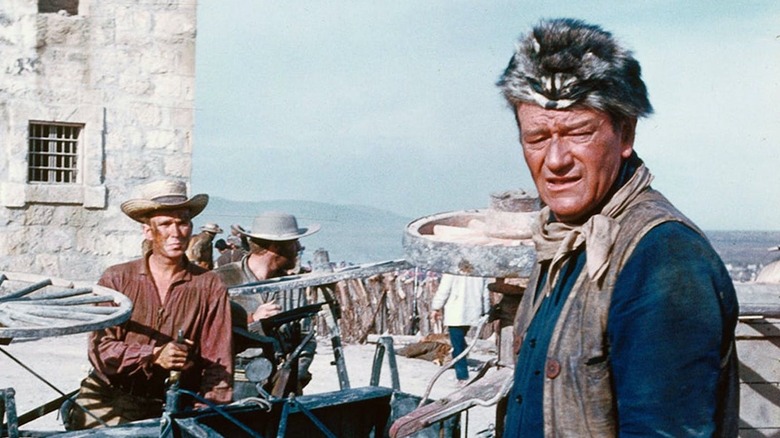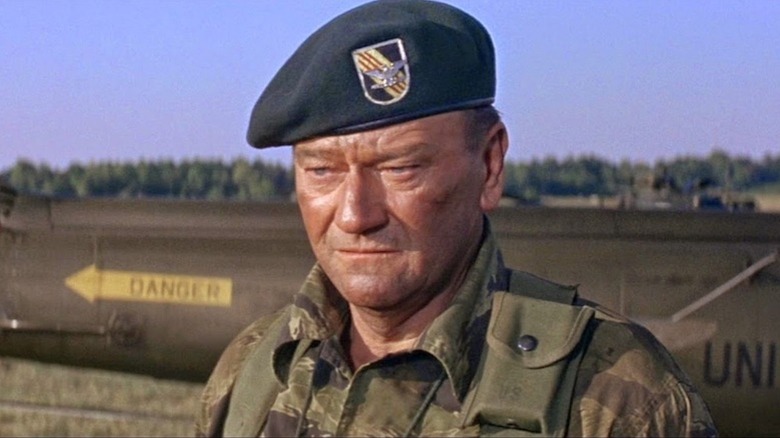John Wayne Only Directed Two Movies In His Career (And They're Both War Stories)
It is a time-honored tradition in Hollywood that at a certain point of a movie star's career, they'll give an interview during which they'll reveal, "What I'd really like to do is direct." If what they'd also like to do is win an Oscar, it's not the worst idea. Established actors Robert Redford, Warren Beatty, Richard Attenborough, Kevin Costner, Clint Eastwood, Mel Gibson, and Ron Howard all earned the Academy Award for Best Director, so the allure is there. Whether they've the talent and temperament to call the shots behind the camera is something you can't know until they give it a shot. Unless that person is Gary Busey.
The movie star's desire to direct wasn't so much of a thing in the 1940s and 1950s. If actors had aspirations beyond on-screen renown, they generally wanted to produce. This is what the biggest star of this period, John Wayne, did when he launched his Batjac Productions in 1952 with the godawful "Big Jim McLain," a political thriller that valorized House Un-American Activities Committee investigators busting communists in post-WWII Hawaii. Batjac didn't always make rotten movies. The company's existence would eventually be justified by its backing of Budd Boetticher's brilliant Western "Seven Men from Now" (which Paul Schrader and Ethan Hawke want to remake) in 1957 and Frank Borzage's WWII romance "China Doll," but before the creation of the company, Wayne had a vision for an epic that would hopefully be his crowning cinematic achievement.
Since 1945, he'd wanted to make a movie about the Battle of the Alamo, and he ultimately realized that, to preserve the integrity of his vision, he would have to direct it. This would be the first of two times Wayne dared to step behind the camera. Both were war films, and they both fell well short of their artistic ambitions.
John Wayne's movie star swagger didn't translate behind the camera
On paper, the idea of John Wayne directing himself as Davy Crockett in "The Alamo" sounded like a winner. Released in 1960, when Wayne's presence all but guaranteed a tidy profit, the movie was hyped to the heavens. Critics, however, were unimpressed, and the film's punishing 161-minute length (202 minutes if you caught the roadshow release) wore on moviegoers. Viewed simply as a meat-and-potatoes, rah-rah patriotic spectacle, it fails to get the blood up. Richard Widmark, the biggest name in the movie next to Wayne, expressed displeasure with the star's heavy-handed directing. Others were more complimentary of the Duke's behind-the-camera manner, but when the film made a disappointing $20 million on a $12 million budget ($1.5 million of which Wayne claimed came out of his pocket), Hollywood figured this would be the last time the star took a crack at directing.
Hollywood figured wrong. In 1968, animated by the public's wavering support for the Vietnam War, Wayne and Batjack rallied behind an adaptation of Robin Moore's semi-fictional "The Green Berets." Wayne made no bones about the fact that his film was meant to turn public sentiment on the conflict, so he played ball with the Pentagon across the board. When the U.S. Army asked for Moore, whose account was not explicitly pro-war, to be excluded from the production, Wayne bought the writer out.
"The Green Berets" is now considered one of the worst films of Wayne's career, and flat-out one of the worst films ever made, but it made $35 million on a $7 million budget. If nothing else, Wayne proved that he was still bankable in a war flick. But in taking a co-director role alongside Ray Kellogg, his interest in filmmaking seemed to be waning. Wayne would continue to wield a tremendous amount of power as a star-producer until his retirement in 1976 with Don Siegel's "The Shootist," but he never directed another movie. In retrospect, we can safely say he wasn't cut out for the job. But he was a better hire than Gary Busey.

